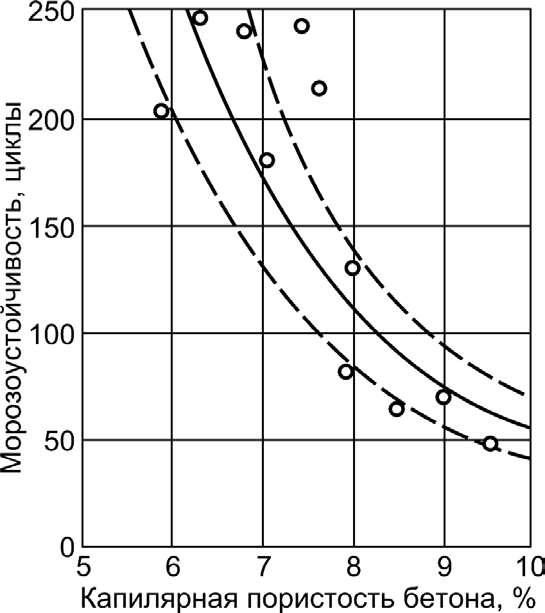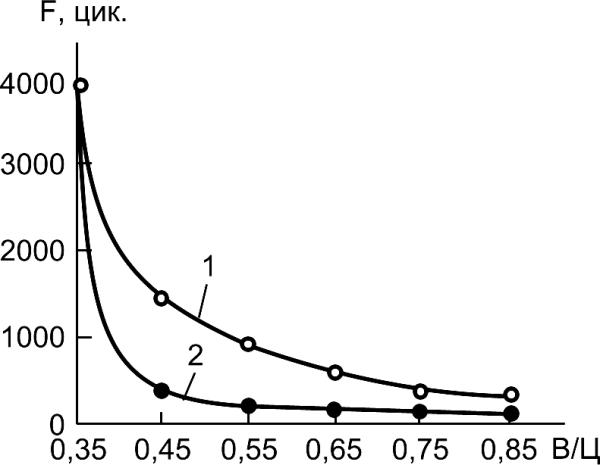CHAPTER 6
CONCRETE RESISTANCE TO
TEMPERATURE-HUMIDITY
INFLUENCE.
CORROSION RESISTANCE
L. Dvorkin and O.Dvorkin





Concrete durability is provided at accordance its composition and
structure to conditions of constructions performance.
6.1. Frost resistance of concrete
Reasons of frost destruction of concrete. Frost resistance of concrete is
ability to keep strength and working ability at action of cyclic freezing and
thawing in the water saturating conditions.
At present, there is no general theory explaining the reason of frost
destruction of concrete though it is obvious that finally, strength decrease of
damp concrete at cyclic freezing and thawing is caused basically by formation
of ice in concrete pores. As the volume of ice is about 9 % more than volume
of water, there is significant pressure that can rupture concrete and gradually
loosen its structure.
According to a T.Powers hypothesis of hydraulic pressure the main reason of
concrete destruction at cyclic freezing and thawing is the hydraulic pressure
created in pores and capillaries of concrete under influence of freezing water.
At enough volume of entrained air voids excess water gets in air voids and
prevents concrete damage.
105





According to modern representations hydraulic pressure is not the unique
reason of frost destruction. Destruction is also developed by the action of
osmotic phenomena. They result increase in concentration of the dissolved
substances (Са(OH) , alkalies, etc.) in a liquid phase of concrete on border
2
with an ice. Diffusion of water to area of freezing creates additional pressure.
Factors affecting frost resistance of concrete. Influence of cyclic
temperature change additionally increases due to action of salts solutions.
For example, different deicing chemicals (NaCl, CaCl ) used for ice removal
2
from road surfaces.
At presence of salts the osmotic phenomena in frozen concrete increases and
viscosity of a liquid phase raises. As a result hydraulic pressure increases and
destruction of concrete is accelerated.
Frost resistance of concrete is caused basically by its porous structure.
The temperature of freezing of water in concrete depends on the sizes of
capillaries. For example, in capillaries 1,57 mm in diameter water freezes at
-6,40C; 0,15 mm at -14,60C; 0,06 mm at -180C. In capillaries less than 0,001
mm in diameter water almost does not freeze.
106






The air voids received by adding in concrete mix an air-entraining admixture,
essentially change structure of a cement stone. The number of air voids per 1
cm3 of cement stone can reach one million and a surface of these voids may be
within the range of 200 to 250 cm2. Protective action has only small enough in
size air voids — less than 0,5 or 0,3 mm in diameter.
It is possible to divide all technological
ing
factors governing frost resistance of
haw
e,
concrete on two groups:
d t
1. Factors defined by conditions of
stanc
an
si
ng
construction exposures;
e
zie
2. Factors considering features of
ost r
initial materials, structure, composition
Fr
s of fre
of concrete and its hardening
le
conditions.
cyc
Capillary porosity of concrete, %
Fig.6.1. Effect of capillary porosity on
frost resistance of concrete
(from Gorchakov)
107





Very important factors defining frost resistance are also the degree of watersaturation and temperature of freezing of concrete.
Strength decrease of concrete after freezing and thawing is possible only at its
water-saturation above the certain value.
Comparative determination of frost resistance of concrete by freezing at -17
and -50°C has shown that destruction of concrete in the second case is
accelerated significantly (6 to 10 times).
Design of frost-resistant concrete. The volume of the open capillary voids
influencing quantity of frozen water, depends on the water-cement ratio (W/C)
and degree of cement hydration.
With increase W/C increases both total volume of open capillary voids and
their average diameter, that also worsens frost resistance.
The second characteristic defining capillary porosity of concrete is degree of
cement hydration which depends on cement strength, rate of hardening, time
and conditions of concrete hardening.
108






Cycles of freezing
and thawing
Mineral admixtures in frost-resistant concrete
especially with the large water requirements are
undesirable. At the same time, it is experimentally
shown that concrete with non-large maintenance
of ground granulated slag or fly ash may be
satisfactory frost-resistant, especially at adding in
concrete an entrained air.
Increase of specific surface of
cement over 400 m2/kg reduces
frost resistance of concrete. Such
W/C
super-fine cements are
characterized by large shrinkage.
Fig.6.2. Relationship between frost resistance
and water-cement ratio (W/C) of concrete:
1 – Air-entrained concrete;
2 - Non-air-entrained concrete
109





Air-entraining admixtures are produced in the form of the concentrated
solutions, pastes or in the form of dry and easily soluble powder.
Measurement of frost resistance. The standardized method of an
estimation of frost resistance of concrete is characterized by number of
cycles of freezing and thawing of specimens under standard conditions of
test without essential strength decrease.
The system of normalization of frost resistance offered by us according to
which number of cycles of freezing and thawing (F) of laboratory
specimens is not given; a class of frost resistance of concrete is more
rational. For example:
1 class – non-large frost resistance (F=50 to 150),
2 class - large frost resistance (F =150 to 300),
3 class - high frost resistance (F=300 to 500),
4 class - especially high frost resistance (F> 500).
All methods of definition of concrete frost resistance can be divided in
experimentally-calculated and calculated methods.
Experimentally-calculated methods define corresponding experimental
parameters (strength, modulus of elasticity, water absorption, etc.) and
then approximate number of cycles of freezing and thawing of concrete.
110





Calculated methods allow to define approximately frost resistance of concrete
"a priori" that is without preliminary trial mixes. Such methods represent special
interest at designing (proportioning) of frost-resistant concrete mixtures. At the
same time, calculated concrete mixtures necessary to check experimentally.
As a result of statistical processing experimental data we offered the following
formula for determination of frost resistance of concrete (F):
F = К(10 kF − )
1
,
(6
.1)
where К - factor depending on the kind of cement (for ordinary normal
Portland cement K=170);
F - modified compensatory factor can be determined by the formula:
k
V
+ V
F
air
contr
=
(6.2)








































